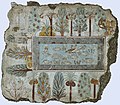| Tomb of Nebamun | |
|---|---|
 Fowling scene | |
| Period/culture | 18th Dynasty |
| Discovered | 1820 Theban Necropolis |
| Discovered by | Giovanni (Yanni) d'Athanasi |
| Present location | British Museum, London |
| Website | |
The lost Tomb of Nebamun was an ancient Egyptian tomb from the Eighteenth Dynasty located in the Theban Necropolis located on the west bank of the Nile at Thebes (present-day Luxor in Egypt). [1] The tomb was the source of a number of famous decorated tomb scenes that are currently on display in the British Museum, London. [1] [2]
Contents
The location of the tomb was not revealed at the time of its discovery in order to maintain secrecy during a period of competition between excavators, and was since lost. Scientific analysis in 2008–09 indicated the tomb's location in the vicinity of Dra' Abu el-Naga'. [3]




